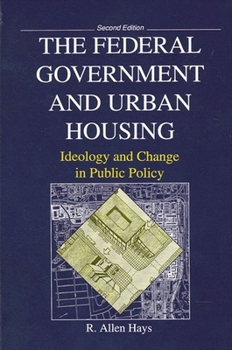The Federal Government and Urban Housing: Second Edition
Select Format
Select Condition 
Book Overview
This book provides a complete picture of federal housing and community development policy during the last sixty years. Since the first edition was published in 1985, the quality and quantity of published works on U.S. housing policy have increased considerably. But this book still stands out from other works in the breadth of its coverage and analysis. This second edition covers virtually every major program that has attempted to provide housing for disadvantaged persons and compares and contrasts their underlying approaches to housing problems. It also examines the impact of major community development programs-urban renewal and Community Development Block Grants-on urban housing. The coverage of U.S. housing policy extends through the first year of the Clinton administration.
Most notably, Hays calls into question the generally negative appraisal of housing programs that is widespread in the public policy and urban politics literature. He shows that although most of these programs have experienced major problems, none has been an unqualified failure, and most have improved the housing conditions of millions of people. Placing the federal government's attempts to deal with housing problems within a broader analytical framework by relating them to long and short-term political changes, Hays argues that the political variable with the most impact on the course of housing policy has been ideology-in particular, the ideological orientations of the various presidential administrations during the past sixty years.
Most notably, Hays calls into question the generally negative appraisal of housing programs that is widespread in the public policy and urban politics literature. He shows that although most of these programs have experienced major problems, none has been an unqualified failure, and most have improved the housing conditions of millions of people. Placing the federal government's attempts to deal with housing problems within a broader analytical framework by relating them to long and short-term political changes, Hays argues that the political variable with the most impact on the course of housing policy has been ideology-in particular, the ideological orientations of the various presidential administrations during the past sixty years.
Format:Paperback
Language:English
ISBN:0791423263
ISBN13:9780791423264
Release Date:March 1995
Publisher:State University of New York Press
Length:348 Pages
Weight:1.01 lbs.
Dimensions:0.9" x 6.0" x 9.1"
Customer Reviews
1 rating
Ideology and Urban Housing
Published by Thriftbooks.com User , 19 years ago
The main premise of Hays' work on federal housing programs is that ideology serves as a significant influence on the development of public policy. Like Sabatier's Advocacy Coalition Framework, Hays sees coalitions based on a core set of values as influencing the agenda setting aspects of the public policy system. Furthermore, Hays argues that the conflict which emerges between rival ideological coalitions for control of political institutions and policy subsystems shapes which policies reach the governmental agenda and additionally shapes the "ideological direction" of policies. In attempting to describe the ideological structure of the American political system, Hays uses three tenets of traditional capitalism as his starting point. First, human productivity is driven by self-interest. Second, the market is the most effective means of allocation of goods and services. Third, government should play a secondary role to market forces. However, due to changes in the American political system, these tenets have become less concrete and are readily malleable by differing ideologies. Hays divides the modified beliefs between conservative and liberal ideologies. According to Hays, conservatives favor governmental "interventions which strengthen and encourage additional productive activity by those economic actors who are already winners in the private market struggle and interventions which reinforce the direction the market system is taking on its own" (22). The liberal ideology, on the other hand, "believe[s] in the more active use of government to restrain and channel the activities of the market," including initiatives which will create a more equitable distribution of resources, and takes an active role in shaping social relationships (22). Because of the entrenched ideologies of conservatives and liberals Hays argues that the responses of the ideological categories can be, to some extent, predicated. However, in addition to the ideological beliefs engrained in conservatism and liberalism, each policy area has its own history which may also influences the shape of policy. Still, regardless of how much a particular policy system may be in possession of its own unique history, the deeper lying ideologies and the subsequent conflicts often shape the direction of policy. Hays writes that such conflicts, "illustrate how the broader struggle for power among competing visions of the government's role in the economy set the stage upon which narrower, more specific policy dramas are played out" (56). In the face of such perpetuating conflict, a question arises; can public policy attain an optimal state in the face of all these competing ideological interests? Hays would argue that indeed, a relatively optimal solution can emerge. Hays suggests that an optimal solution to conflicting interests emerges as a result of a learning process which occurs throughout the progression of public policy programs. Hays writes, "that past mista






